The Mystery of the Missing Antimatter - an Introduction to CPT Symmetry. (Particle Physics Series – Episode 4C)
We have seen in a previous episode that matter–antimatter pair creation and annihilation should respect conservation laws. Yet, we only observe antimatter in minute quantities. Shouldn’t there be the same amount of each type around us?
And if there were, wouldn’t all matter and antimatter have already annihilated, leaving our Universe flooded with photons only?
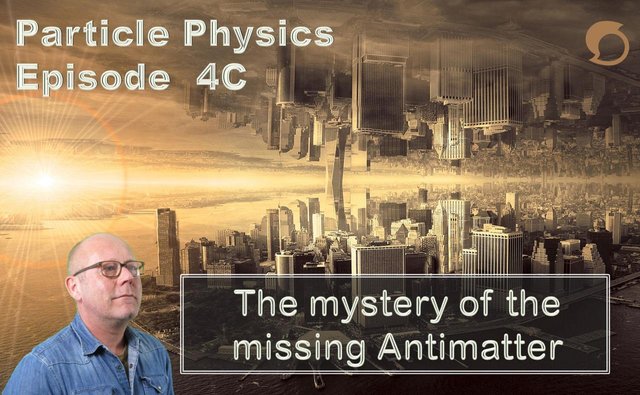
Well, I have some partial answers to offer you.
First, we will travel through time from the big bang and witness how matter (and antimatter) came to be.
In a second section, we will discuss asymmetries in the behaviors of matter and antimatter, asymmetries which are actually observed experimentally. To really enjoy the trip, we will dive deep into one of the most fundamental theorems in Physics, The CPT theorem.

1/ Table of content and preliminary notes
To enjoy reading this post, you do not need a deep prior knowledge in particle physics (apart from the paragraph about CP violation). Yet, to fully understand all concepts presented, feel free to brush up a little by reading the previous articles first.
- Episode 4A, “Antimatter, the mirror world” presents the fundamentals about antimatter.
- Episode 4B, “Matter and Antimatter – An Explosive Couple!” dives into the interaction of matter and anti-matter (pair production and annihilation). Appendices are included at the end of this paper if you need a recap on particle physics fundamentals.
- Episode 4C (this one) goes back in time instants after the big bang and witnesses the birth of matter and antimatter in the universe. It also explores matter/antimatter asymmetry and The CPT theorem.
- Episode 4D will concern the detection of antimatter in our universe. Are there anti-planets, anti-stars and anti-galaxies?
- Episode 4E will wonder if we could be the neighbors of an antimatter universe?
Now, let’s dive in!

2/ Witnessing the birth of matter and antimatter.
Let’s go back far in time, just a hundred thousandth of a second after the big bang.
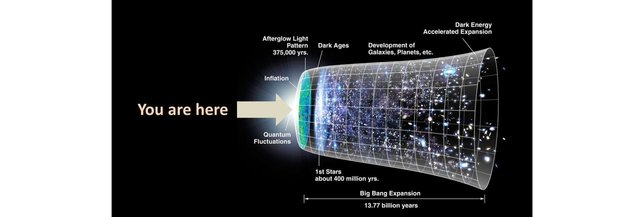
The surrounding temperature is a staggering ten trillion degrees. Matter is under the form of a soup of quarks, antiquarks, gluons and photons with a density of around 100 million tons per cubic centimeter. Yet, this state does not last for long… The Universe is expanding and cooling rapidly. Soon enough, Quarks and antiquarks condense into protons and antiprotons.
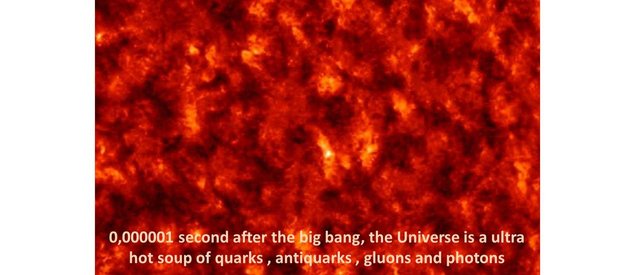
But, already, anti-protons are at a deficit compared to protons… Antimatter is disappearing. The universe cools further, and the last anti-quarks take refuge into composite particles of lesser energy: mesons (assembly of one quark and one anti-quark). The latter do not stay stable for long, and by just a millisecond after the big bang, positrons appear to be the last remnants of antimatter…
The creation of electron-positron pairs requires less energy than that of quarks and antiquarks pairs, so leptons are still going through their genesis while the universe cools down at a temperature of around 10 billion degrees. The Universe is now 1 second old.
10 seconds later, the positrons go missing leaving only protons, neutrons and electrons.
We learned that, from energy, matter and antimatter are created in equal ways to preserve conservation laws. And then, when a particle and an antiparticle meet they annihilate releasing energy under the form of gamma photons.
Everything around us is obviously composed of matter. So where is the antimatter? Why such an asymmetry? Shouldn’t the universe be only made of photons (the product of matter-antimatter annihilation).

In order for you to follow the detective work of the scientists investigating this asymmetry, I need to introduce you to a concept called the CPT theorem.
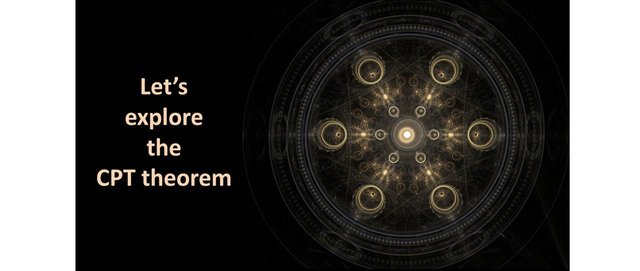
3/ The CPT Theorem
When a fundamental theory or idea is proposed, there is a way to verify if it should be considered for further study or if it is just nonsense. See this like a kind of quality control protocol. The fundamental criterion to be considered is the in-variance of the proposed theory under certain symmetries. That means that if I apply a specific symmetry to a reaction the theory predicts and that is observed in nature, the resulting reaction should also be observable in Nature.
There are 3 fundamental symmetries that are to be considered: C (Charge), P (Parity) and T (Time reversal). The symmetry operators can combine, for example the CP operation consists in applying the C-symmetry and the P- symmetry simultaneously. The ultimate test for the invariance of a theory is to apply on it the CPT symmetry. It is not an easy concept to grasp, so let me give it a try by going into some details.

3.a - The Charge Symmetry
The charge symmetry is an operation where the electric charges of particles are swapped.

The C-symmetry transform the sign of a charge but not its magnitude. Consequently, the electromagnetic forces remain the same. Take two electrons, each charged negatively with the elementary charge -e. Place them close to each other: they repel each other with a given force.
Now apply the C-Symmetry to this system. Both particles will have the sign of their charge swapped to a positive charge +e. Other than this, nothing changes: they still repel with the same force...
You would expect that C-symmetry is always respected... Well, counter-intuitively, this is not the case. Not all reaction in our universe are C-symmetric.

3.2 - The Parity Symmetry
The parity symmetry is an operation where the directions in space are reversed: In the diagram below is represented the spin of electrons. the P-symmetry changes the direction of that spin from clockwise to anti-clockwise and vice-versa
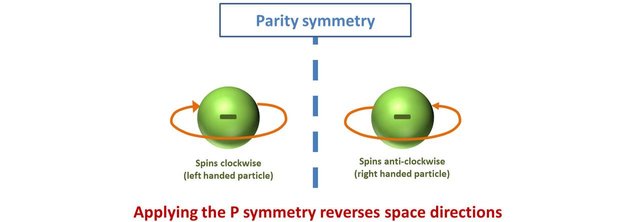
Let’s see what we mean when we say that a reaction is P-symmetric. This symmetry appears obvious to common sense but is not that obvious when digging into small scale physics. Imagine a reaction occurring in nature. Say, two electrons have a trajectory such that they are approaching each other, while both moving from left to right. An exchange of photons between them will modify their momentum as in the drawing below.
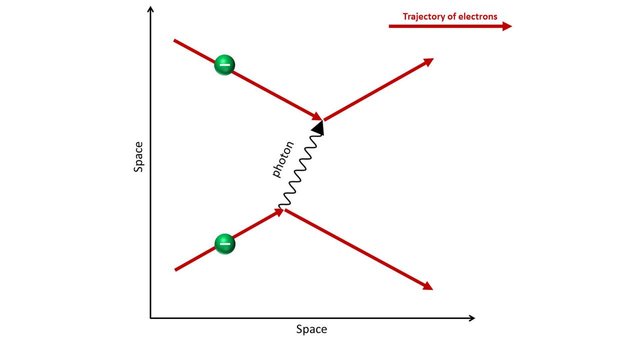
If a reaction as seen in a mirror exists in nature, then it is said to be P-Symmetric. The P symmetric reaction involving our two electrons would correspond to the same phenomena but with the electrons moving from right to left this time…
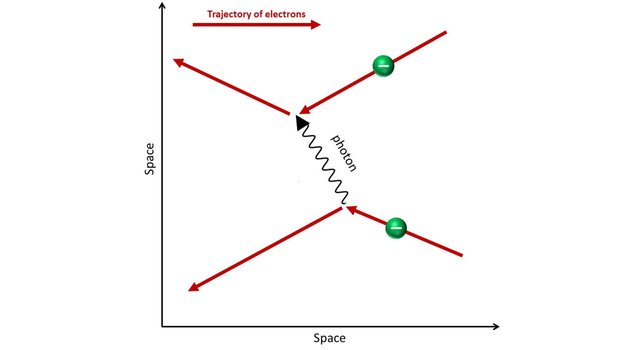
I actually played around with a mirror...

You would expect P symmetry to be respected by all phenomena in nature. Again counter-intuitively this is not the case either.

3.3 - From Matter to Antimatter, The CP Symmetry
Now let’s check out what happens when I apply both C and P symmetry operations on a real particle.

As you may observe, combining C and P symmetries transforms our electron into... a positron, the anti-matter counterpart of the electron.
Consequently if nature respects CP symmetry, that implies that matter and antimatter should have a perfect symmetric behavior… thus be formed in the same amounts and in the end, completely annihilate each other… This is obviously not the case because we are here! So proving that not all reactions are CP symmetric is key in explaining the dominance of matter, thus our existence.

3.4 - The Time Reversal Symmetry
The time symmetry is an operation where the direction in time is reversed. Imagine you record on your fancy camera, an electron coming towards you while spinning clockwise. Then, you watch the movie in reverse: what you observe is the electron going away from you while rotating anticlockwise…
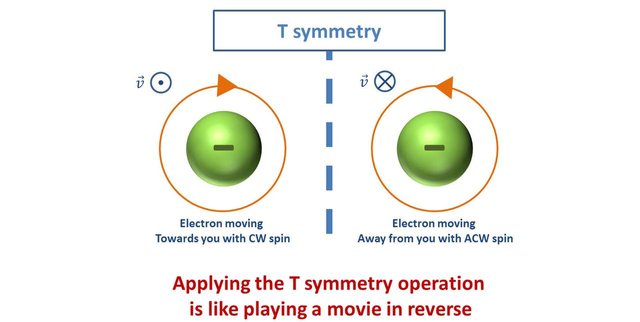
You can also think of what it means for a reaction to be T-symmetric. Imagine that you record with your video camera an interaction between particles: say two incident particles A and B with given momentum and energy meet up, interact and form two new particles C and D with their respective momentum and energy.

Now play your video backwards, you should observe particle C and D meeting up and as a result of their interaction, produce particles A and B with the same momentum and energy they had in the forward reaction. In addition, the probability of occurrence of the time-reversed reaction should match with that of the forward reaction.

If such a time reversed reaction can be observed (or theoretically provoked) in nature, it implies that this reaction is T-Symmetric.

3.5 - The CP and T Symmetries are Complementary…
Here, I will make a wild approximation to illustrate a point (the specialists might jump out of their chair here ;-) ). We mentioned that T symmetry transforms a negative charge going towards you into a negative charge moving away from you: The latter can be considered equivalent as a positive charge moving toward you (the rate of change of the electric potential at the observer's position will be identical in both cases). This equivalence is massively used in electronics and electrical sciences. Thus we could approximate that the T symmetry transforms an electron into a positron.

Looks kind of familiar, don’t you think?
Yes, it looks furiously like the CP symmetry operation. Both CP and T appear complementary…
So combining all three C, P and T operations simultaneously ends up with an invariance: When applied on an electron spinning clockwise and going towards you, the CPT symmetry produces an electron spinning clockwise and going towards you :
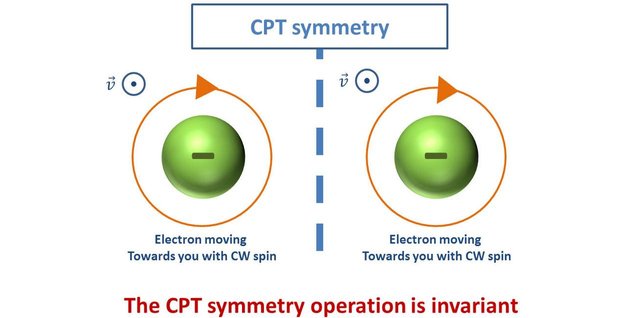
This invariance of the CPT symmetry is a pillar in Physics. The violation of this symmetry has never been observed experimentally. If a theory does not respect it, then it is automatically invalidated.
It has been experimentally observed that Nature violates C and P symmetries. as well as CP and T symmetries. However, when CP is violated, it is accompanied by a violation of T which compensates so that CPT remains invariant.
The matter – antimatter unbalance is therefore possible without violating the most fundamental symmetries of all, the CPT symmetry.

3.6 - Experimental Proof of CP Violation.
We have seen in the previous paragraph that the dominance of matter over antimatter could be explained by the violation of CP symmetry. Such variation has been observed in multiple experiments.
The first indirect sign of such a violation was discovered in the asymmetry of oscillation of Neutral Kaons by Cronin, Fitch and Christenson.
There are two types of Neutral Kaons that naturally oscillate which means that they transform continuously from one type into the other.

In this oscillation process, a violation of CP symmetry occurs because the probability of a transformation from one type to another is slightly different than the reverse transformation.
A direct violation was experimentally observed experimentally much later in the 90s by looking at the decay of neutral Kaons into Pions. This involves a complex piece of theory, so I will need to bend a few lines here to make it easy to grasp for the non-initiated ;-). So again, my apologies to any specialist that happens to stumble across these lines.
As written above, the two types of neutral Kaons oscillate from one type to the other. As we are in the realm of quantum mechanics, there is an inherent uncertainty in knowing, at a given time, if a given Kaon is of one type or the other. The trick used here is to construct linear combinations of both states that then can be manipulated mathematically. This leads to the description of two new states for the particle labelled K1 and K2.
Roughly:

Kaons decay into pions. In order to respect CP symmetry, K1 particles can only decay into 2 pions (+ a lot of kinetic energy), and K2 particles into 3 pions (with little kinetic energy).

As you know from a previous episode, a decay is more probable when the product of a decay is of lower mass. Consequently, particles in the K1 state are shorter lived than particles in the K2 state by a large factor. This implies that K1 and K2 can be separated experimentally allowing them to be renamed Kshort and Klong respectively.
The experiment that was carried out in the nineties consisted in sending a beam of Kaons into a long tube, long enough for all the Kshort to have decayed during the travel to the detector. Consequently, a pure Klong beam was produced.

It was observed that a small fraction of the Klong were decaying into 2 pions only. They should all be decaying into 3 pions. This phenomena violates CP symmetry...
Since then, more intense CP violating processes have been observed in the decay of B mesons (a Meson that contains a Bottom quark). A detailed article can be found here:
" The discovery of CP violation in B-meson decays " (Takasaki et al)

4/ So do we know now why matter dominates our observable universe?
Unfortunately, no… The experimental observations of CP violations could explain why matter dominates over antimatter, however, the degree at which CP violations occurs is much too small to explain the extent of the asymmetry between matter and antimatter. More asymmetric processes of much larger significance need to be found to explain why matter is predominant.
There is another option (here, beware: personal opinion!)…
Spacetime in our universe is measured flat at +/- 1%. This implies that what we observe is just a tiny sample of reality: The observable universe is most probably extremely small compared to the Universe with a capital U.
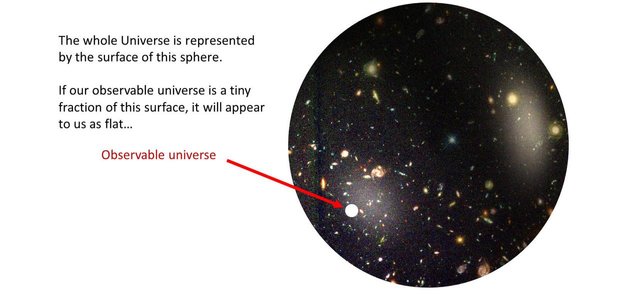
We cannot exclude that in other regions, forever hidden from us, matter is not the dominating type of matter present… We might just be mislead by a sampling bias, trying to find something (a fundamental asymmetry) that is just not there.
As we cannot observe what lies beyond the horizon of our observable universe, the apparent predominance of matter might be just an illusion. This is one of the ideas we will explore in the next episode!
So stay tuned!
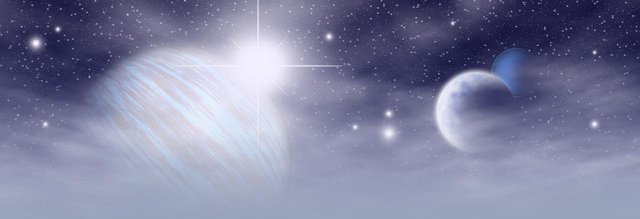
The 'Particle Physics' series is aimed at providing an introduction to the world of small scale physics to non-scientists and high school students preparing for their high school exams.
Previous episodes:
- Elementary particles, the building block of reality (Particle Physics Series – Episode 1)
- Composite particles: let’s play Lego! (Particle Physics Series – Episode 2)
- Elementary fermions: the particles of matter… (Particle Physics Series – Episode 3A)
- Where does the mass of hadrons come from? (Particle Physics Series – Episode 3B)
- Let quarks be free! (Particle Physics Series – Episode 3C)
- Antimatter, The Mirror World (Particle Physics Series – Episode 4A)
- Matter and Antimatter – An Explosive Couple! (Particle Physics Series – Episode 4B)
Can't wait to know more?
If you can't wait to dive deep into the antimatter world, there are already some excellent articles on Steemit written by a professional particle physicist, @lemouth.
- Live from CERN - What does antimatter say when it falls?
- Live from CERN - Measuring antimatter properties with hybrid matter/antimatter atoms (without destroying the world)
- Live from CERN - ELENA is so beautiful that antimatter gets slow
- Antimatter strikes back: the CPT symmetry and the revenge of the antiproton magnetic moment at BASE (CERN)

Sources, references and to dig deeper:
- https://en.wikipedia.org/wiki/CPT_symmetry
- https://www.quantumdiaries.org/2011/11/14/what-exactly-is-cp-violation/
- https://www.quantumdiaries.org/2009/09/28/symmetry-in-physics-pt-2-discrete-symmetries-and-antimatter/
- https://en.wikipedia.org/wiki/Parity_(physics)
- https://en.wikipedia.org/wiki/C-symmetry
- Book: L’anti-matiere (Gabriel Chardin)

Image credits:
- Big bang illustration (By NASA/WMAP Science Team (Original version: NASA; modified by Ryan Kaldari) [Public domain], via Wikimedia Commons (link)
- All other pictures and visual elements are free for use commercially and were found either on Pixabay.
- Scientific illustrations and diagrams produced by @muphy.
- All illustrations, diagrams and friezes put together by @muphy using elements found on Pixabay.

Hi,
I’m @muphy (see intro post),
My life revolves around music production, teaching sciences, and discovery through travel.
You enjoyed that post? Resteem and Upvote!
You are interested in these topics? Follow me!
Without reading I thought about the following possibilities:
Black holes swallowed different amounts of matter and anti matter, and created an imbalance.
There may be parts of the universe where the imbalance is opposite to how it is here.
1&2. Both options do not contradict each other.
Well the best is to read the article before commenting ;-),
I am with you fully for 2/, but not so with 1/. In order to respect the CPT theorem, a particle and its antiparticle should have the same mass, therefore respond the same way to gravitational fields, like those of a black hole... As for Hawking radiation, there is no reason to believe that the process of having one of the virtual particles gobbled up, thus the other becoming real, would be asymmetrical: it can either be the particle or the antiparticle, in equal amount.
For the second point, this is what makes most sense to me compared to a much larger assymetry than observed via CP violations and that has not be found yet (if you read the last paragraph, you'll see this). Principle of Occame's razor.
The issue is that no signal from antimatter stars or galaxies will ever be able to reach us because beyond the horizon of the observable universe....
So... because we can't test this hypothesis.. how scientific is it to even propose it?
The debate is open :-)
You got a 44.44% upvote from @luckyvotes courtesy of @stimialiti!
You got a 60.00% upvote from @sleeplesswhale courtesy of @stimialiti!
You got upvoted from @adriatik bot! Thank you to you for using our service. We really hope this will hope to promote your quality content!
You got a 47.36% upvote from @proffit courtesy of @stimialiti!
2-25% Return on investment. Check steembottracker.com for current status
Minimum 0.01 SBD/STEEM to get upvote , Minimum 1 SBD/STEEM to get upvote + resteem
This comment has received a 76.92 % upvote from @steemdiffuser thanks to: @stimialiti.
Bids above 0.1 SBD may get additional upvotes from our trail members.
Get Upvotes, Join Our Trail, or Delegate Some SP
Great post!
Good explanation of a difficult concept.
So some assymetry at the time of the big bang would explain the absence of antimatter in our visible universe?
Hello @Irelandscape. Thanks, I have been away from STEM posting for a while, I am glad to be back with this paper that took me quite a while to put together (and I am pretty proud of it as it kind of is at the frontier of my comfort zone;-))
Yup, that's right. it is an asymmetry, instants after the BB, that explains why antimatter is so scarce today. It would have been quite significant at the time. Your question rises a thought:
The CP violations we know of are too weak nowdays to explain the unbalance between matter and antimatter. Could this violation have fundamentally changed in magnitude in time? hmmm, I am not in favor of that.
But, on the other hand, I could admit that at these ultra high energies, there could be some very asymmetric processes that we haven't identified yet (for example, at the point of phase change when the gluon-quark plasma condenses into hadrons. )
It would be interesting to have the point of view of a specialist here (@lemouth) :-)
Yes, I would guess (but that's only a guess), that the assymetry so soon after the BB would have a much greater effect than later in the history of the universe?
I could be wrong about that.
Or maybe, it is still there, but we haven't identified it, or maybe it just doesn't exist (see last paragraph arguing of a sampling bias due to the flatness of the universe), or maybe we just got it terribly wrong lol!
Welcome back BTW! :-)
Cheers, am glad to be around, and to interact with you guys again!
Cheers, am glad to be
Around, and to interact
With you guys again!
- muphy
I'm a bot. I detect haiku.
I liked your personal opinion on it. As usual, I could be picky about details, like the spinning illustration of the spin. But I won't as this may confuse the reader and not do any good :)
For a third time, glad to see you back! :)
I agree. Actually in my deepest opinion, representing a particle as a little sphere is utterly incorrect, but we do have to help ourselves a little with some kind of visual representations, especially for those not too savvy of Quantum Mechanics maths, like me :-)!
Finally let's discuss a little bit about it, because I like chatting with you and I missed this :)
One fun fact is that if one takes the upper limit on the electron radius (of about 10-18 m) and considers the electron as a spinning sphere, one can calculate its rotation speed. One will find that it is about one million times the speed of light... This shows the naive interpretation does not work.
On the other hand, one also have particles with a spin higher than 1/2. Then, it becomes just impossible to interpret the spin as a rotation :)
The mechanistic representation (not really an interpretation ;-)) does indeed not make any sense. I am curious though how you come to the linear speed of a point on the surface of the sphere at 1 million times c, that’s 3 x 1014 m/s. I back calculated, that means rotation speed would be 1030 rpm and a centripetal acceleration of around 1047 m/s2! Lol!
My personal representation of spin is… no representation… It is just a state, like color for gluons, or even happy or sad for human beings. No geometry is involved… But it does help when dealing with symmetries…
And for a particle, it is the same, I do not see it as a particle, I do not see it as a wave… I do not even see them as a variation in a field in a physical sense. I see these more like the variation of a mathematical function in space-time (I am from the school that believes that reality is an emergent property of a mathematical construct)… I know it is weird, it is a little like thinking that ideas are real, and reality as we know it results from them… But it is the only way my (Brownian ?) brain can make sense of it all…
Yet, these physical representations are really practical to understand and predict things. But they do have limits. The caution is to know at what point one needs to back off, and allow a more abstract view. And that’s where I regret having had bad a terrible maths teacher in high school and consequently not taking an advanced maths course at Uni ;-).
Take an angular speed ω around the z axis. A point located at a distance r from the center (in spherical coordinate) lies at a distance r sin θ from the z axis. It will therefore rotate with a velocity ω r sin θ.
Let us now calculate the angular momentum. We need to integrate over a sphere of radius R and constant density ρ the quantity ω ρ r2 sin2 θ dV. This gives
L = 2/5 m v R
where m is the electron mass and v=ω R.
Now, for having this being associated with a spin of 1/2, we must also have
L = 1/2 hbar.
The rest is easy and you get v = 5/4 hbar / (m R) = 1.45 1014 m/s.
This is what is important. We need to keep in mind the limits of the representations. I hope we will meet at Virgo in September :)
Thank you @leMouth, it made me revise my moments of Inertia :-).
I would love to come to Virgo in September! Yet, It will corresponds to the second week of the scholar year, a time where my agenda is a just a big mess... not the best period to plan things ahead. Still, I am reflecting if I could manage it as it could be quite something!
Fingers are crossed! :D
How could the universe start with one single point?
Well, I am part of those that do not believe our Universe started from a mathematical point without an underlying context.
My school of thought on that matter is Eternal Inflation: This means that the Universe would have popped out of existence because of a significant quantum fluctuation within an inflationary field. The Big Bang and the inflation that soon followed, would not correspond to an accelerated expansion of space, but to a local decceleration of that same expansion (from our perspective, being inside, it looks like an explosion coming from a single point).
I also believe that Dark Energy would be a remnant of that field, that hence has locally taken another stable (metastable?) state... resulting in the conditions that allow our universe to be the way it is (containing matter, stars, galaxies, human beings, etc...).
I am probably wrong, but as of today it is what makes most sense to me...
Hi muphy, and thank you for your most excellent respond to my question. I am overwhelmed by your answer and I am looking forward to your next post.
Thank you Sergio. If my answer stuns you, that means you might have caught the virus! Your should explore eternal inflation and multiverse theories to get really flying high!
Lol now I know how Colonel Jack O'Neill feels
Great article, for me all this concept are very complicated but you explained very well.
Thank you! This is a very nice compliment. Actually, it is not that complicated, just different from what we encounter usually. If you have any question, or ideas, feel free to ask or share!
Hi @muphy!
Your post was upvoted by utopian.io in cooperation with steemstem - supporting knowledge, innovation and technological advancement on the Steem Blockchain.
Contribute to Open Source with utopian.io
Learn how to contribute on our website and join the new open source economy.
Want to chat? Join the Utopian Community on Discord https://discord.gg/h52nFrV
Wow great to see you after a long time missed seeing your content on steemit but now its awesome to learn more from you :)
Thank yu Blazing, having been away for quite a long time, I am glad to be back :-)
Great to know that time to learn and know more :D
This is quite an exhaustive post.
Science is just so awesome.
Welcome back
Upvote this blog post. https://steemit.com/christianity/@bible.com/verse-of-the-day-hebrews-4-16-nlt